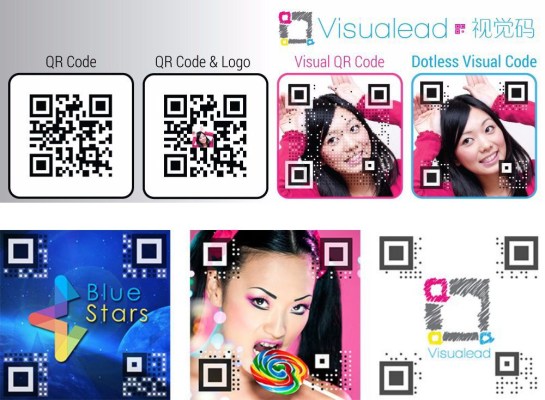Many in the West are still dumbfounded that QR codes are a thing. Well, heads-up, the humble QR code as you know it is being disrupted. At least that’s according to Visualead, an Israel-based startup backed by Alibaba that announced a new ‘dotless’ format today.
Alibaba, which invested ‘millions’ in an undisclosed round for Visualead in January, is among the first to trial dotless QR codes. There are multiple benefits to the new format, Visualead CEO and co-founder Nevo Alva told TechCrunch, including 90 percent more space for branding and messaging from retailers and tighter security.
“This is the next step from the visual QR code. Our development is based on feedback that we got from the market,” Alva said, “And it will make codes more obvious for consumers to interact with.”
In addition to enabling a clearer call-to-action, Visualead said the new QR codes are “practically impossible to imitate” which will help Alibaba, and other retailers, battle counterfeits. Indeed, Alibaba — which received a lawsuit from U.S. luxury goods companies just last week — is launching its ‘Blue Stars’ campaign that uses dotless QR codes within its Taobao marketplace. Merchants print out and attach a label to each package, which customers can then scan to verify the authenticity of the goods they receive.
Taking a step back for a second, QR codes are big business in Asia, and particularly China, where they are a key mechanism for facilitating online-to-offline commerce — take a ride on the Beijing subway and marvel at how many codes are included in ads. Alva claimed that visual codes can be four times more effective at getting a response from customers.
Clearly, a QR code startup founder is bound to wax lyrical about QR codes, but there are some pointers to back his claim up. In addition to Alibaba’s investment — which was the company’s first in a startup in Israel — Visualead has racked up over 500,000 customers on its freemium service, though Alva would only say that “hundreds of thousands” pay for the service in some form.
Like anything, however, introducing a new standard takes time. Alva is optimistic that getting Alibaba on board will help dotless codes gain adoption with greater speed.
“In one day we can penetrate hundreds of millions of devices [via Alibaba’s Taobao app],” he said.
As for the West, Alva isn’t giving up hope. He said he believes that a little time and the right partners can help QR codes realize the potential that he believes they offer.
“People in the West say it is just a code, and it’s been ‘going to die’ every year for last five years. When we talk about O2O [online-to-offline retail] there are several guidelines that we have to have in place: education and penetration.
“These are two very important things. In China, you can see how big companies are pushing QR codes. [In the West,] it depends on several things, we have to find the right partner,” he said.
Facebook’s move to turn Messenger into a platform and the additions of payments is moving towards commerce, while rival messaging app Tango have fully embraced shopping last week. Even Amazon’s effort to simplify things with Dash, a physical button for re-ordering items, shows how things are moving — though scanning a QR code seems far easier and more flexible. As messaging apps in the West become commerce channels, as they already are in the East, so the winds of change may blow for QR codes in the West.
Visualead isn’t sitting around waiting, however. Alva hinted it is in discussions with companies in the U.S., although he declined to say which ones. Likewise, he said there’s a lot more to come.
“Yes, it’s a code, but if you use it right, the amount of things you do with it are endless,” he argued, hinting that Visualead is preparing to move into several new segments in the coming period.
